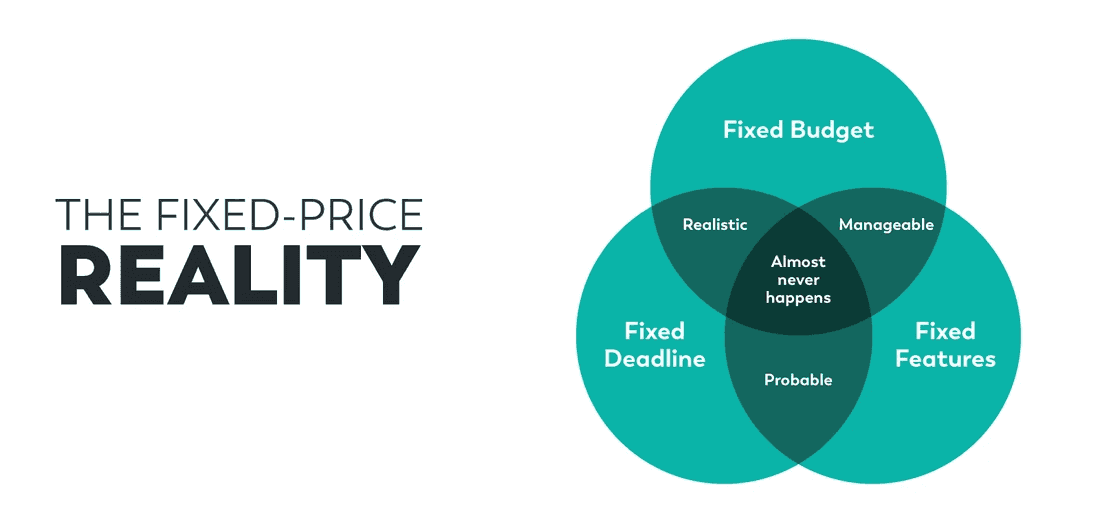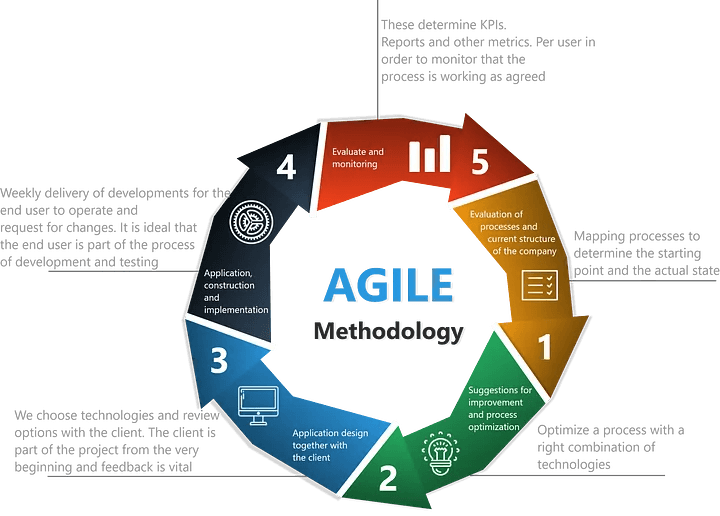For a long time, the fixed-cost development methodology has been the go-to solution for developing software.
But, the unpredictability of the digital era requires businesses to adapt quickly to changes to save on time and cost while meeting the users’ expectations.
That’s why modern-day businesses are inclined to use more radical software development methodologies, and the agile approach seems to take the cake.
Not only does it allow a business to respond quickly to change, but it also promotes continuous development.
A survey on agile methodologies found that a staggering 61% of companies apply this method in software development and company-wide transformation.
If you’re new in the software development market, you’re probably wondering which model suits your company.
We’ve prepared a guide detailing their differences to help you make an informed decision.
Understanding the Fixed Cost Development Model
The fixed cost development model is one that requires the vendor and the client to agree on the price, scope, and timeline at the beginning of the project.
The premise of this model is to provide the client with a clear understanding of the project’s total cost for better cost control and budgeting.
The success of this model is only possible if the parties can establish the project’s scope and requirements from the onset.
As such, careful documentation and elaboration of deliverables is necessary to avoid conflict.
After defining all such elements, the client and the service provider sign a contract to formalize the terms of the project and enforce accountability.
The model can be summarized as follows:
- Define the project scope
- Define the project requirements
- Set the timeline and the budget
- Define the deliverables and milestones
- Sign a contract

Image: Visual to summarize a fixed cost development model
Advantages of Fixed Cost Development Model [h2]
The predictability of a fixed-cost development model makes it appealing to many companies. Statistics show that 51% of software companies still use the model to develop software.
In addition to the predictability of the project cost and deliverables, it presents other advantages:
Clear Project Scope
The model defines the scope of the project at the beginning. To avoid ambiguity, the client and the service provider outline the project’s requirements, deliverables, and specifications in writing.
Such clarity makes it easy to outsource a software development project to a third party, and you’re confident that the project will be executed flawlessly.
Also, the contract acts as legal proof for the project, protecting the client from losses.
Predictable Project Cost
A fixed cost development model provides the project cost from the onset, helping clients budget.
They know the exact cost they must invest in the product and can look for investors with that certainty.
Also, the lack of continuous negotiation ensures that the service provider focuses on timely delivery and quality.
Reduced Risk
The model requires both parties to sign a contract that significantly minimizes the risk of project failure.
The project’s scope, budget, and timelines are defined clearly, eliminating the potential for budget overruns and scope creep.
The development team can deliver high-quality products within the stipulated parameters if well-communicated.
Timely Delivery
Setting the project timelines from the beginning keeps the development team focused on delivering the product on time.
The team must adhere to strict deadlines, which helps project managers track milestones and monitor the project’s progress.
Timely delivery promotes operational efficiency and enhances client satisfaction.
Overview of Agile Development Model
The agile software development model anticipates change during the development process. It focuses on making small, progressive increments throughout the project.
Thus, parts or pieces of the software are delivered over time and not the entire application.
This means the development team and the client must constantly communicate to ensure the project tasks are tailored to emerging needs.
If the team discovers that a process or task could be done differently and provides more value to the customer, they do it.
The Agile development model is ideal for complex projects and those with uncertain requirements. Four principles define this development model:
- Collaboration in lieu of contract negotiations: Project execution using this model requires great partnership between the client and the service provider. As such, the provider involves the customer in the entire development process, not just at the beginning and end
- Emphasis on the software, not the documentation: Prior models required developers to dedicate chunks of time to documenting the product. This approach was time-consuming and often led to delays in delivery. The agile model still supports documentation but only of information required to execute a task
- Emphasis on individual interactions: Human resources are at the core of any software development project. That’s why the agile model is more people-centered
- Adaptability to change: The agile approach embraces and adapts to change. The short iteration during the development process allows developers to make changes easily

Image: Visual to highlight the agile development process
Benefits of Agile Development Model
The agile development model presents many benefits:
Enhances Customer Satisfaction
Its iterative approach allows teams to gather feedback from customers throughout the process.
The team uses such information to improve the quality of the product and ensure it meets the customer’s needs.
Better Quality of the Final Product
The model focuses on continuous improvement and delivery, which makes it easy to improve the quality of the end product.
Features are added or changed as the project progresses, producing a better final product. More importantly, there’s no delay in delivery because changes are made on the go.
Better Adaptability
Flexibility is at the core of agile methodologies. Project teams can make changes as they develop the product due to unforeseen circumstances or user demands.
For example, the client can add or remove a feature to the product, and the agile team can do it without disrupting the development process.
Reduced Risks
According to the chart, companies that use agile development methodologies to execute large projects have a 19% success rate compared to 8% for companies using waterfall methods.
The agile development model makes it easy for teams to work together towards a similar goal.
This means they can immediately resolve problems when needed, reducing the probability of project failure.
A study comparing agile and waterfall development models found that agile approaches increase a large project’s success rate two times compared to its counterpart.
Also, small projects using the agile development model had a much higher success rate (59%) than those applying the fixed cost model (45%).
Also Read: An Executive's Guide to Agile Product Development
Comparing Fixed Cost and Agile Models
| Factor | Fixed Cost Model | Agile Model |
|---|---|---|
| Documentation | Requires much documentation at the beginning of the project without accounting for oversights or issues that could happen during the project’s execution | There isn’t much documentation as the changes are made on the go. The premise for documentation is to understand the project’s requirements, not to determine implementation |
| Flexibility | It’s not flexible as the project’s requirements, timelines, and deliverables are defined at the beginning of the project. | The method is more open to change. The development team liaises with the client throughout the project’s lifecycle making changes based on the user’s need or uncertainties |
| Collaboration | The client’s input is required at the beginning of the project and intermittently during its lifecycle | The development team collaborates with the client throughout the project |
| Project delivery | Project delivery is at the end of the project | Favors continuous delivery |
| Execution | The project is executed in linear phases | The project is executed in small, progressive iterations also referred to as cyclical phases |
| Review | The model makes it challenging to review performance because the product is delivered at the end of the project | Encourages constant refinement to adapt the project to changes |
Making the Decision: Factors to Consider
In addition to factoring in their differences, there are factors developers must consider when choosing between a fixed cost or agile development model. They include:
Project Requirements
Projects have unique requirements that must be addressed before choosing a development model.
This includes defining the product’s functional requirements, like the desired outcomes, user interactions, integrations, etc.
You also want to factor in non-functional requirements like usability, accessibility, security, and scalability.
Identifying and documenting the product’s requirements provides a clear roadmap for the team to choose a befitting software development model.
Project Size
The project size has a significant bearing on the development methodology you can use.
Larger projects, for example, are best executed using the agile development methodology to allow adaptability.
Conversely, a fixed cost model is more suitable for shorter projects as they have shorter testing times and fewer requirements.
Project Complexity
The development team must also assess the project’s complexity. For example, a project characterized by technical challenges or high-risk factors would benefit from an agile development model.
The model helps teams break down complex tasks into smaller, more manageable parts to allow incremental progress.
Conversely, simple projects with easily defined objectives, activities, and deliverables can be implemented using the fixed cost development model.
For example, for a simple project involving building a website, it is easy to estimate the cost and timeline. Your team has built one many times; hence, it is likely to use a fixed cost development model.
Understand the Project’s Constraints
A project's constraints can determine the development model to use. If handling a project with documented and well-understood constraints, then the fixed cost model is a better pick.
Conversely, when dealing with a project whose constraints, scope, or timeline are challenging to determine in advance, it would help to use agile methodology.
Start Your Next Development Project with Imaginovation
Choosing between fixed cost and agile development models can take time and effort. A team must consider the project's needs, complexity, and size. A fixed cost development model is an excellent pick if you're big on precision and predictability.
However, an agile model is more appropriate if you prefer collaboration, adaptability, and evolving with a project's needs. Either model can be applied successfully depending on the project's circumstances.
But if you're in limbo, you can always enlist the help of our team. We've worked on numerous projects and can help you analyze the project's requirements to identify the best model. Contact us! today.




